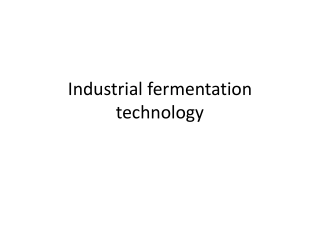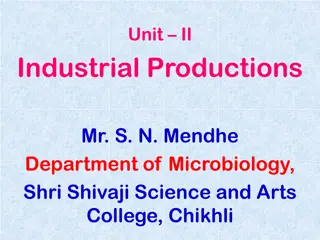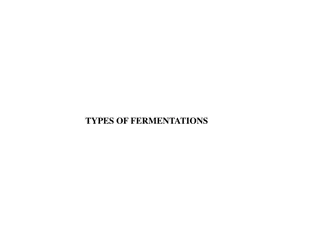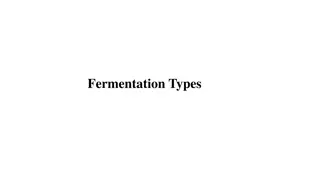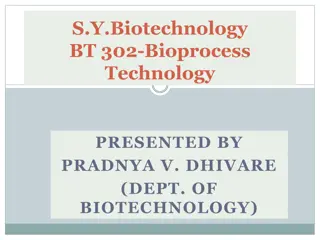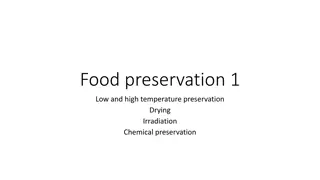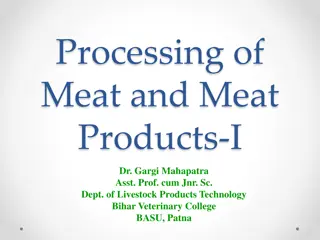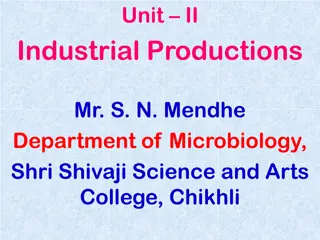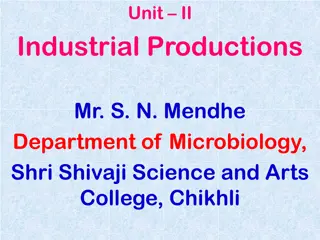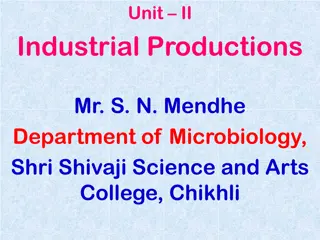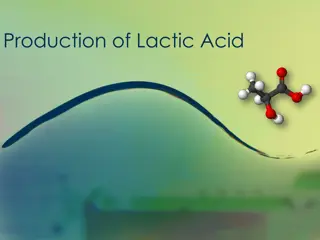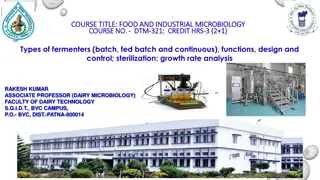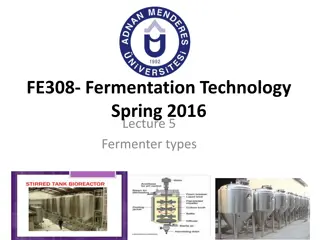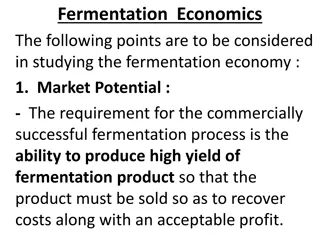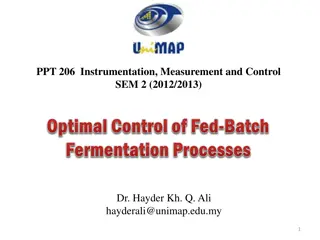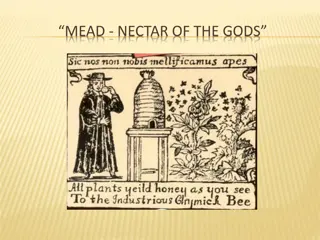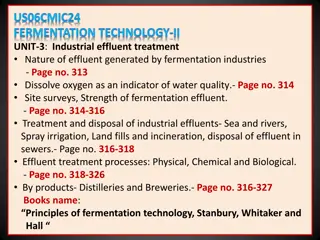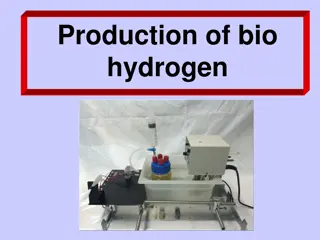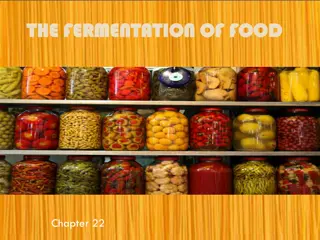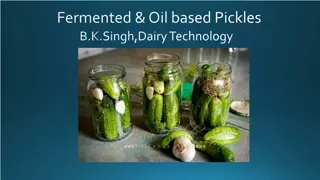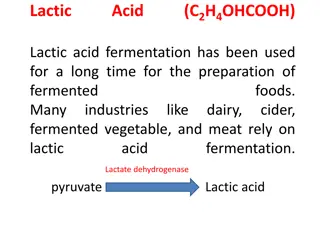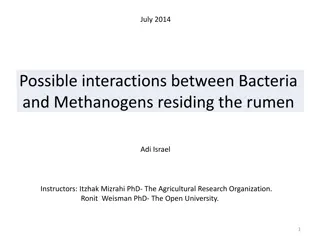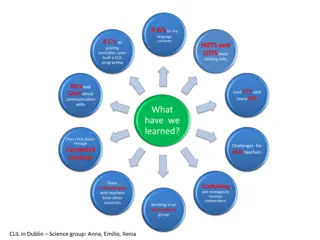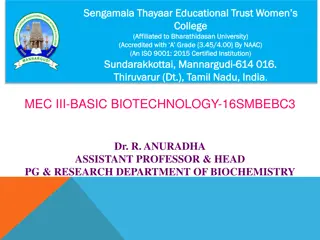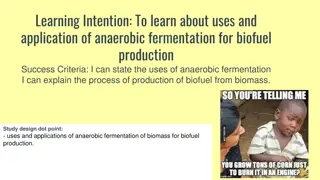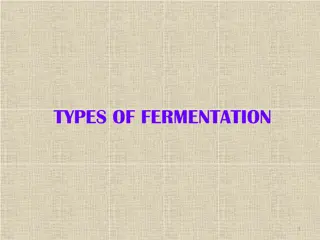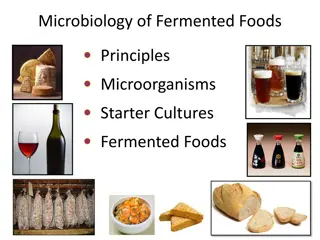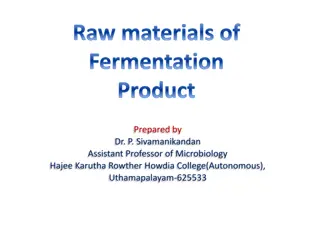Respiration
The definition and role of aerobic respiration, the overall sequence of reactions for glucose, and the two-stage process. Explore the concepts of anaerobic respiration and fermentation, including the role of microorganisms in industrial fermentation. Discover the cellular location of each stage and
0 views • 11 slides
Industrial fermentation technology
Industrial fermentation technology involves three key stages - Up-Stream Processing (USP), the fermentation process, and Down-Stream Processing (DSP). USP includes formulating the fermentation medium, sterilization, inoculum preparation, and improving desired microorganisms for increased productivit
1 views • 23 slides
Precision Fermentation in Sustainable Food Production
Precision Fermentation is a specialized bioprocessing technique that utilizes microbes as cell factories to produce specific functional ingredients like proteins, vitamins, enzymes, and more. This innovative technology addresses the challenges of increasing food demands in a sustainable way, offerin
1 views • 12 slides
Our Beautiful Stinky Friends
Delve into the fascinating world of fermentation with chef/scientist David Zilber in this insightful listening guide based on the Science Friday podcast. Explore the science, ingredients, and techniques behind fermentation as Zilber shares his expertise and tips for home fermenters. Enhance your kno
0 views • 9 slides
Yeast Breads Preparation Guide
Explore the world of yeast breads with essential information on yeast, ingredients, terms to know, mixing methods, and baking tips for successful bread making. Learn about the role of yeast as a microscopic plant and the key ingredients needed to create delicious bread. Discover important techniques
0 views • 12 slides
Biogas Production and Methane Content Measurement in Biodigester Research
Explore the process of collecting data in biodigester studies, focusing on biogas production, methane content, and related measurements. Learn how to read water levels, measure biogas, and assess methane content using sodium hydroxide or potassium hydroxide solutions. Practice techniques with fermen
0 views • 20 slides
Industrial Production of Ethyl Alcohol: Processes and Microorganisms
Ethyl alcohol production from molasses involves specific steps like selecting yeast strains, preparing inoculum, and creating fermentation conditions. Yeasts like Saccharomyces cerevisiae play a crucial role due to their alcohol tolerance and rapid growth properties. The process requires careful han
1 views • 23 slides
Industrial Production of Citric Acid and Microbial Fermentation
Industrial production of citric acid has evolved from extraction processes to microbial fermentation, offering various industrial applications. Citric acid is utilized as an acidulant in food and pharmaceutical industries, a chelating agent in tanning, and a flavor enhancer in carbonated beverages.
1 views • 18 slides
Understanding Different Types of Fermentations
Alcoholic fermentation involves the production of ethanol, commonly carried out by yeasts like Saccharomyces cerevisiae. On the other hand, lactic acid fermentation results in the production of lactic acid through two types: homo-fermentative and heterofermentative pathways. Different substrates and
2 views • 23 slides
Understanding Types and Benefits of Solid State Fermentation
Fermentation is a metabolic process involving enzymes transforming organic substrates. Solid state fermentation (SSF) is a method without free water, crucial for enzyme production using natural materials like grains and fruit pulps. This process is cost-effective, environmentally friendly, and easy
1 views • 15 slides
Understanding Bioprocess Technology and its Applications
Bioprocess technology involves utilizing living cells or their components like bacteria and enzymes to produce desired products through fermentation. This field covers a range of processes, including microbial bioprocesses, enzyme production, metabolite synthesis, recombinant products, and transform
0 views • 15 slides
Understanding Fermentation as a Food Preservation Technique
Fermentation is a natural process where microorganisms alter the sensory and functional properties of food to create a desirable end product. This method not only extends shelf life but also improves nutritional value, aids digestibility, and enhances food safety. Fermentation does not require expen
1 views • 31 slides
Industrial Production of Citric Acid: Fermentation Processes and Applications
Citric acid is industrially produced through microbial fermentation processes. It is widely used in various industries such as food, pharmaceuticals, and beverage production. Different methods like surface culture fermentation are employed for citric acid manufacture, with fungi like Aspergillus nig
4 views • 18 slides
Understanding Meat Processing Techniques and Procedures
This article discusses the processing of meat and meat products, including basic and advanced procedures such as comminution, emulsification, and curing. It delves into the importance of size reduction, emulsions, and stable meat emulsions in enhancing the quality and characteristics of meat product
0 views • 21 slides
Industrial Production of Acetone and Butanol from Corn
Industrial production of acetone and butanol from corn involves a process reported by Beesch in 1953, which includes steps like using specific Clostridium species for fermentation, inoculum preparation, and recovery through distillation. The method has been essential for producing acetone and butano
0 views • 15 slides
Understanding the Industrial Production of Vinegar
Vinegar fermentation, with its rich history and diverse classification based on raw materials, involves two essential fermentations - alcoholic fermentation and acetous fermentation. Various microorganisms, particularly Acetobacter species, play a crucial role in vinegar production. Different method
0 views • 15 slides
Industrial Production of Wines: Process and Classes
Wine production involves fermentation of grapes with variations in color, alcohol, and sugar content, resulting in different classes of wines like red, white, sweet, dry, sparkling. The process includes grape selection, fermentation, aging, and bottling to create high-quality wines.
3 views • 16 slides
Overview of Lactic Acid Production and Applications
Lactic acid occurs in two isomeric forms and has various applications in food, pharmaceuticals, and skincare industries. It is primarily produced through the fermentation of sugars by microorganisms. The production process involves using raw materials like purified sugars and agricultural wastes. Th
4 views • 11 slides
Understanding Triple Sugar Iron Agar (TSI Agar) Test
Triple Sugar Iron Agar (TSI Agar) is a differential media used for identifying gram-negative enteric bacilli based on carbohydrate fermentation and hydrogen sulfide production. It helps detect carbohydrate fermentation, gas production, acidification, and H2S formation, providing valuable information
1 views • 28 slides
Understanding Fermentation and Bioreactors in Food and Industrial Microbiology
Fermentation is a crucial process where substances break down into simpler forms using organisms, generating energy. Bioreactors are systems supporting biochemically active environments for specific organisms, either aerobic or anaerobic. Learn about the history, importance, and applications of ferm
1 views • 16 slides
Understanding Fermenter Design and Functionality
The fermenter is essential in the fermentation process, providing a controlled environment for biomass and product yields. It enables aseptic fermentation, optimal mixing, and aeration without excessive power consumption. Key functions include temperature control, pH regulation, and minimizing evapo
1 views • 36 slides
Understanding Fermentation Economics: Key Market Considerations
Studying the fermentation economy involves assessing market potential, competition, cost recovery, and distribution strategies. Market demand, competition, production costs, and potential profits are crucial factors to consider for successful commercial fermentation processes. Foreign sales can offe
0 views • 19 slides
Principles of Fed-Batch Fermentation in Biotechnology
Explore the concept of fed-batch fermentation, a key technique in biotechnological processes. This method involves adding nutrients in controlled doses based on specific criteria to optimize cell growth and minimize undesirable metabolic pathways. Fed-batch systems allow for high cell densities and
0 views • 24 slides
Unveiling the Secrets of Mead: History, Making Process, and Fermentation
Delve into the world of mead, the ancient nectar of the gods, as we uncover its rich history dating back to the Paleolithic Period. Learn about the simple ingredients used in mead making, the role of yeast in fermentation, and the preservation benefits of this divine beverage. Explore the wisdom beh
9 views • 24 slides
Industrial Effluent Treatment in Fermentation Industries
Fermentation industries generate various types of effluent containing organic matter, solids, and other waste materials. With stricter regulations on waste disposal, efficient treatment methods are essential for controlled disposal. This includes physical, chemical, and biological processes to treat
0 views • 84 slides
Bio Hydrogen Production Experiment: Materials, Set-Up, and Procedure
This experiment focuses on the production of bio hydrogen using sugar beet cuttings and dried cultures as substrates. The materials required include a bioreactor, fuel cell, and various components for setting up the experiment. The experimental set-up involves preparing the fermentation bottle, subs
0 views • 18 slides
Understanding Yeast Dough: Types and Techniques
Yeast dough is the foundation of various baked goods, offering a canvas for creativity with different types such as lean, soft, and enriched dough. Learn about the basic ingredients, methods like straight dough mixing, and essential concepts like yeast hydration and bulk fermentation in baking. Disc
0 views • 6 slides
The Fascinating World of Food Fermentation
Explore the rich history and benefits of fermentation, from the early nomads' discovery of cheese and yogurt to Louis Pasteur's groundbreaking work. Learn about the different types of respiration, microbial fermentation in food production, and the energy-releasing process of cell respiration. Discov
0 views • 13 slides
Fermented Vegetables: Health Benefits and Production Process
Fermented vegetables offer a plethora of health benefits, such as aiding digestion, boosting the immune system, and potentially reducing the risk of certain diseases. Sauerkraut, a popular fermented cabbage dish, is a common example, known for its distinct sour flavor and nutritious profile. The fer
0 views • 20 slides
Lactic Acid Fermentation in Food Industry
Lactic acid fermentation is a widely used method for producing fermented foods like dairy, vegetables, and meats. This process involves lactic acid bacteria and filamentous fungi to convert sugars into lactic acid. Various microbial cultures are utilized, and raw materials such as whey, molasses, an
0 views • 23 slides
Interactions Between Bacteria and Methanogens in the Rumen
The rumen, an anaerobic fermentation chamber in ruminant animals, houses a diverse microbial community including bacteria, fungi, protozoa, methanogenic archaea, and phages. Methanogens play a crucial role in methane production using fermentation end products. Research aims to explore evidence of in
0 views • 21 slides
Applications and Industrial Production of Fermentation in Various Sectors
Fermentation plays a crucial role in the production of organic solvents, food products, condiments, dairy products, processed meats, beverages, vitamins, and pharmaceutical compounds like antibiotics and vaccines. Specific examples include the production of citric acid, lactic acid, monosodium gluta
0 views • 6 slides
Understanding Triple Sugar Iron Agar (TSI Agar) Test in Microbiology
Gain insights into the Triple Sugar Iron Agar (TSI Agar) test used for differentiating gram-negative enteric bacilli based on carbohydrate fermentation and hydrogen sulfide production. Learn about detecting carbohydrate fermentation, interpreting results, and performing the test accurately with deta
0 views • 28 slides
Exploring Alcoholic Fermentation Using Yeast in CLIL Science Lesson
This CLIL lesson focuses on the process of alcoholic fermentation using yeast in brewing, baking, winemaking, and cider production. Students will learn about metabolism, biotechnology applications, and different cultures in Europe. The lesson includes activities to build understanding through hands-
0 views • 4 slides
Ethanol Production from Biomass: A Biochemical Perspective
Ethanol is a crucial ingredient in various products and beverages and can be produced from plant fermentation or the hydration of ethylene. This process involves utilizing wastes and plant products like molasses, sugar beets, and maize to convert carbohydrates into ethanol. The biochemistry of ethan
0 views • 21 slides
Understanding Cellular Respiration and Fermentation Processes
Cellular respiration is the energy-releasing process in which organisms take in glucose and oxygen to produce carbon dioxide, water, and energy. This process is vital for all living organisms. Photosynthesis and respiration are opposite processes, with respiration requiring the products of photosynt
0 views • 10 slides
Anaerobic Fermentation for Biofuel Production: Uses and Applications
Anaerobic fermentation is a key process converting biomass into biogas without oxygen. Biofuels, such as bioethanol and biodiesel, derived from biomass like agricultural and industrial waste, offer renewable and environmentally friendly energy alternatives. The applications of anaerobic fermentation
0 views • 11 slides
Overview of Different Types of Fermentation Processes
Explore the various types of fermentation processes including batch fermentation, fed-batch fermentation, continuous fermentation, solid-state fermentation, anaerobic fermentation, and aerobic fermentation. Each process has its own advantages and disadvantages, influencing factors such as sterilizat
0 views • 18 slides
Exploring the Fascinating World of Fermented Foods and Microorganisms
Unveil the intricate world of fermented foods, delving into the principles, microorganisms, and starter cultures involved. Discover the fine balance between spoilage and fermentation, the general properties and benefits of fermented foods, and the evolution of the fermented foods industry across tim
0 views • 16 slides
Raw Materials in Industrial Fermentation Processes
Microorganisms utilized in industrial fermentation require essential raw materials such as water, energy sources, carbon, nitrogen, mineral elements, and sometimes vitamins and oxygen. Various raw materials like cane molasses, beet molasses, cereal grains, starch, glucose, and lactose serve as carbo
0 views • 15 slides

